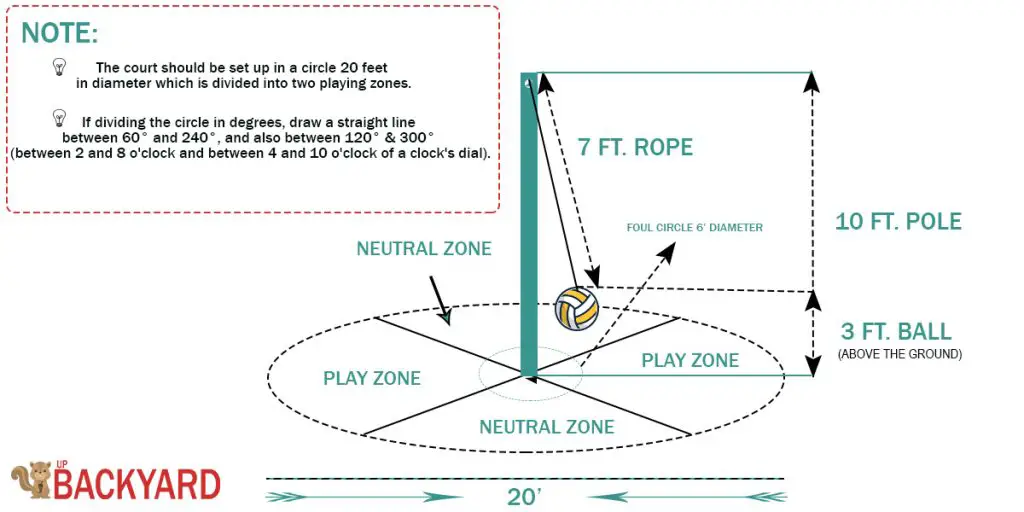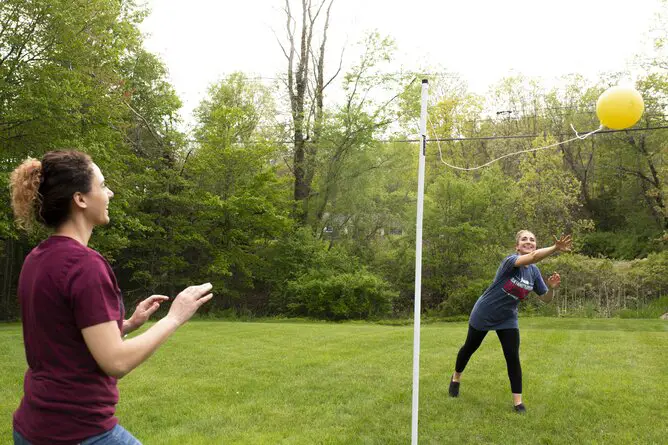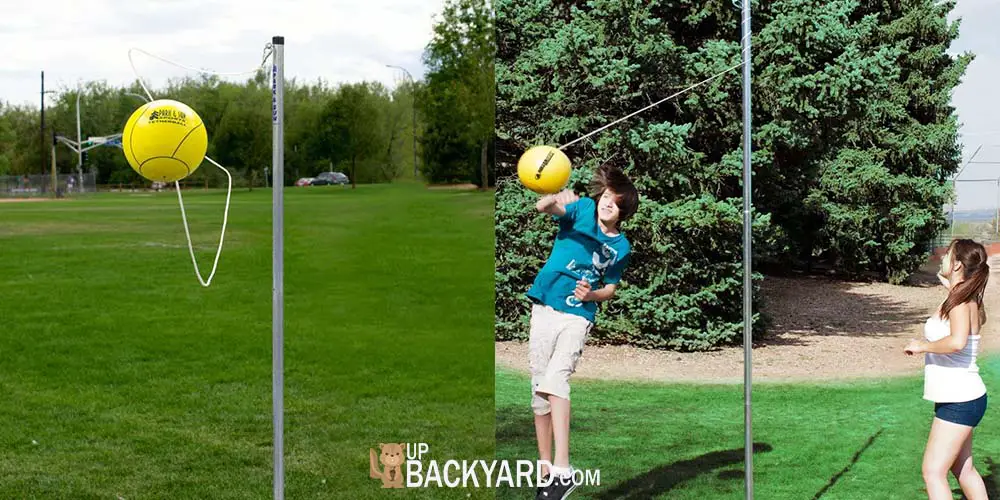Tetherball is an old-fashioned game that used to be played more often than it is now. It has increased in popularity lately thanks to being shown in movies such as Napoleon Dynamite and others, and the best part about it is the fact that it’s super easy to play and an awful lot of fun.
In tetherball, there is a large pole and a ball attached to the end of a long rope, which is attached to the top. Two players compete against one another and hit the ball enough times so that the rope wraps around the tetherball pole. There are certain rules to abide by and each player has their own play area.
Tetherball is not difficult to learn, and in this article, we’ll go over the basics so that once you learn them, you can maybe create your own rules and make the game even more interesting!
The Basics of Tetherball
For starters, you need two players and a tetherball court to play this game. Winning the game involves hitting the tetherball past the other player enough times to allow the rope to wrap around the pole. While hitting the ball, you have to stay within your own boundary, which is clearly marked.
One player on the court hits the ball clockwise, while the other player hits it counter-clockwise. If your opponent isn’t able to hit it when it gets close, the ball continues back to your side, and the more this happens, the more the rope is able to wrap itself around the tetherball pole.
As you can see, the game starts with both players hitting the ball back and forth, but your main goal is to hit the ball out of your opponent’s reach so that it comes back to you. In other words, you want your opponent to miss the ball! This is the gist of a good tetherball game.
Every time the tetherball rope gets wrapped around the pole, it gets shorter. This, in turn, makes the game more difficult for both players. It also affects the speed of the ball. The game is over when the rope is so wrapped around the pole that it simply can’t wrap around anymore.
Of course, just as with any other game, there are rules to follow and penalties that you can incur. Now that you know the basics of a tetherball game, we’ll go into more detail about the specifics of the game. We’ll start with the court itself and what to look for when you start to play.
The Tetherball Court
A full-sized tetherball court is a circle split into four sections. The entire court has a diameter of 20 feet, but you can choose a 16 feet circle if small children will be playing.

To set up the circle, you can do one of two things:
- Draw a big “X” in the middle so that the court is separated into four different sections; use two of those sections for the two players and designate the other two as out-of-bounds areas (Neutral zone).
- Split the court into two sections only, one for each player. With this option, there will be no out-of-bounds or foul areas.
Generally, the pole in the tetherball court is 10 ft. high from the ground to the top of the pole. (Youth courts are often 8 ft instead). The court surface is flat and the pole sits perpendicular to that court. The rope that attaches to the ball is usually around 7 ft. long, but again, this can vary if you like.
In addition, if the ball is hanging by the rope because no one is playing, it will sit 3 ft above the ground. (For kids, it is often preferred to have an 8 ft. pole and a rope that is roughly 6 ft. long so that the ball hangs freely just 2 ft. above the ground.) Again, this is up to you.
By now it should be obvious to you that the rules for tetherball, at least when it comes to setting up the court, are somewhat flexible.
You should stick with the basic rules when setting up your court, but it’s still good to know that you have some flexibility that you’ll likely need when kids are playing.
Setting up the Tetherball Rope and Ball
There are two basic ways to set up your tetherball rope and ball. One involves a permanent tetherball court and the other involves a court that can be considered temporary or portable.

The choice is up to you, and a portable tetherball rope and ball can be set up this way:
- With an air pump, inflate the tetherball
- If the ball isn’t already attached to a rope, go ahead and do this yourself
- Hook up the other end of the rope to the top of your pole, which is normally done with either a carabiner or eyelet
- If you have a portable base, go ahead and fill it up with either water or sand
For permanent tetherball poles, you’ll usually get a pole that is 12 ft. long. This is because 2 ft. of the pole is supposed to be buried in the ground, allowing you to get a 10-foot tetherball pole when measured from the ground to the top of the pole.
Here is how to install it:
- In the center of the court, dig a 2 ft. hole that is about 1 ft. wide
- The next step is optional, but you can place a support base made out of cardboard in the hole then pack tight dirt around it for support.
- Put the pole in either the cardboard base or right into the ground
- Take concrete and place it around the pole
- As the concrete sets, prop up the pole or hold it perpendicular to the ground.
One word of caution: If you do buy a portable tetherball kit, make sure it’s a high-quality one. The super-cheap ones tend not to last for more than a year, so it’s worth it to spend a little extra money and get a good one that will last.
Tips and Reminders About Your Tetherball Game
As with any other game, there is a certain way to start the game of tetherball. The first thing to do is flip a coin so that you can determine who will serve first.
When the first person wins a round, that person will be the server for the next round, and this pattern continues.
Usually, the first server wraps the tether around the pole just once in the opposite direction of the serve. This happens before the game is started.
Now, let’s talk about some more rules regarding how to play the game of tetherball. Some of these rules include the following, which are considered fouls:
- No hitting the ball with anything except your forearm or hand
- No holding or catching the ball or rope
- No touching the pole
- No leaving your specific play area
- No hitting the ball outside of the play area
Keep in mind that when a player fouls, they lose that particular match. In other words, that player automatically loses that particular game.
If both players commit a foul simultaneously, no one wins that particular game. Instead, the game just starts over again with the original server serving the ball.
Tetherball games keep score, and there are a total of seven matches that are worth one point each. Whenever someone wins four of the matches, that person is the winner of the game. A player wins when the tetherball rope is wrapped around the pole as far as it will go.
If each player wins three matches, then one of the players has to gain two additional points or win two additional matches in order to win the game. That means that if you and your opponent both have 3 points, you’ll need to win a total of five matches (instead of four) to win the game.
Sometimes the game is drawn out because of these rules, but it can also make for a much more interesting game in the end!
There are also house rules, which can vary according to who’s playing. In other words, you can make up your own rules when you play tetherball! Some of the most common house rules that other players have played by including the following:
- Players can double-hit the ball while it’s on their side.
- Players can hit the ball with any body part.
- Players can hold the ball for “2 Mississippi”.
- Players can cross over to their opponent’s side of the court without losing
Key Takeaways
Tetherball is played with two players and you play each match until someone fouls. The winner of four out of seven matches is the winner of the game, and the first one who causes the tetherball rope to wrap around the pole completely is the winner of that particular match.
You can choose either a permanent or a portable tetherball game, but if you choose the latter, make sure you get one that is built to last.
Tetherball kits are normally not that expensive, and since it doesn’t take a lot of athletic ability to learn the game well, tetherball continues to be a very popular game.
